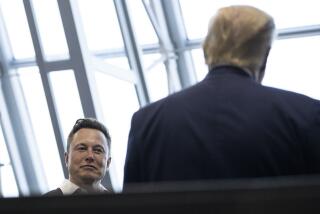BOOK REVIEW : Inventors: A View of the Flip Side : THE INNOVATORS: THE DISCOVERIES, INVENTIONS, AND BREAKTHROUGHS OF OUR TIME<i> by John Diebold</i> E.P. DUTTON $19.95, 303 pages
- Share via
Conventional wisdom has it that great discoveries are almost always made by individuals, working alone, struggling against the Establishment and its twin forces of caution and blindness.
These individuals, nonconformists, are obsessed. They refuse to be thwarted, they suffer for their ideas and occasionally--but only occasionally--they actually win. Organizations, and the conformity they require, are inimical to original thought.
This argument appeals greatly to the congenital troublemakers in the crowd. You know who you are.
In the last year, we have reviewed several books in this space that eloquently expounded this view: “American Genesis” by Thomas P. Hughes (Viking), which cited Thomas Edison, Alexander Graham Bell, Lee De Forest, Nikola Tesla, Orville and Wilbur Wright and Edwin Armstrong, among others, as solitary individuals who refused to conform to the corporate world and who made great inventions as a result; and “Discovering” by Robert Scott Root-Bernstein (Harvard University Press), which praised the mavericks as the only truly creative people in science.
Appealing as this argument is, it may not be right, or at least it may not be the whole story, according to John Diebold, whose book, “The Innovators,” tells the other side of the story. In 12 case studies of contemporary breakthroughs, only one--xerography--was made by an inventor who “fits the classic mold of the solitary genius who struggles alone,” Diebold writes.
“There is no doubt that most recent outstanding innovations emerged from collective efforts in programs sponsored by organizations,” he concludes.
Hughes argued in “American Genesis” that after individuals make their great breakthroughs, corporations are more interested in refining and perfecting them than in making new ones. Diebold argues that just the reverse is true.
For example, he cites the invention of the transistor by John Bardeen, Walter H. Brattain and William Shockley as a crucial discovery that would have died on the vine without concerted, long-term development by Bell Laboratories. The organization, he says, supported and encouraged the original work and then played the vital role of making a working product.
Similarly, though Chester Carlson did indeed invent xerography working alone against great odds, “the key to making xerography a commercial success was an organization that allowed extensive innovation in development, manufacturing and marketing of his invention,” Diebold says.
Transistors and xerography are undeniably important discoveries of the post-war era, but I do wonder a little bit about some of the other case studies included in Diebold’s book. Automatic teller machines? Scotchgard?
Reading the chapters on those inventions reminded me of Mel Brooks’ 2,000-Year-Old Man, who said that the greatest discovery he had witnessed in his 2,000 years on Earth was Saran Wrap. Whatever else our age will be remembered for, I don’t think that it will be automatic teller machines. But who knows?
Federal Express also seems like a questionable inclusion in “the discoveries, inventions and breakthroughs of our time,” though the chapter on Frederick W. Smith and his idea of overnight delivery anywhere was interesting enough.
Diebold’s conception of a breakthrough and his method of telling the stories have a decidedly business-school flavor. The story of fiber optics has more to do with technology than with creativity. Among the other discoveries Diebold considers are the laser, the VCR and cyclosporine (the transplant rejection drug), all legitimate breakthroughs.
Diebold, who has written extensively about computers and business for nearly 40 years, wants to know what it is about some organizations that allows them to escape institutional stupor and respond well to innovators in their midst.
At the 3M Corporation--and at several other places that he discusses--there is a policy of encouraging people to do things, even if it means making mistakes. Management believes and acts on the belief that it is better to try something and fail than not to try at all.
Diebold quotes A. F. Jacobson, chairman and chief executive officer of 3M, as saying, “Human beings are endowed with the urge to create, to bring into being something that has never existed before. . . . It follows, then, that developing entrepreneurs simply means respecting that dimension of human nature and honoring it within the prospect of a profit-making enterprise.”
One wonders whether Diebold’s case studies are idiosyncratic or representative. Of course, the same question can be asked about Hughes’ case studies in “American Genesis,” which came to the opposite conclusion from Diebold’s.
Perhaps the most accurate conclusion to be drawn from both views is that creativity remains a mystery. It can appear in individuals and in groups, and it should be nurtured wherever it is found.
Contrarians, please note: Diebold is the contrarian’s contrarian.
Next: Jonathan Kirsch reviews “History of Private Life, Volume IV” edited by Michelle Perrot.


